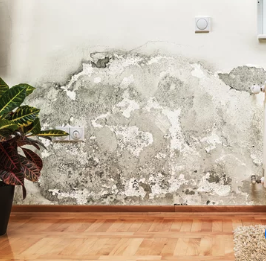Mold cleanup identifies, removes, and prevents mold growth in a building or on surfaces. This guide will provide a step-by-step approach for thorough mold cleanup.
What to Do!
- Identify and remove the source of moisture: Before cleaning mold, it is essential to identify and fix the water source causing it to grow. This could involve fixing leaks, addressing poor ventilation, or other issues causing high humidity.
- Prepare the area: Before beginning the cleaning process, remove any items easily cleaned elsewhere and cover any remaining furniture or surfaces with plastic sheeting to protect them from contamination.
- Clean the surfaces: Using a solution of water and detergent, clean all surfaces affected by mold, including cabinets, furniture, floors, and ceilings. Be sure to scrub thoroughly, paying extra attention to any corners or hard-to-reach areas.
- Dry the surfaces: After cleaning, it is essential to dry them thoroughly to prevent the mold from returning. Using fans or dehumidifiers or opening windows and doors to allow for natural ventilation.
- Dispose of contaminated materials: Any materials contaminated should be carefully removed and disposed
- Inspect and Monitor: After mold cleanup, it’s important to inspect the area after a few days to ensure that mold hasn’t re-grown and monitor the area for any signs of mold and moisture.
- Hire a professional: If the infestation is extensive or you cannot clean it yourself, it’s best to hire a professional mold remediation company with the right tools and knowledge to handle the job safely and effectively.
Mold Cleanup is Essential
- It can cause serious health problems, such as allergic reactions, respiratory issues, and headaches.
- It can also cause structural damage to buildings and homes, leading to costly repairs. Also, mold can create unpleasant odors and negatively impact a property’s overall appearance. Cleaning mold promptly and properly can prevent these issues from getting worse and can help to protect the health and well-being of those who live or work in the affected area.
- Act quickly and take the necessary steps to clean and remove the mold to prevent it from growing and spreading.
Mold exposure can pose a significant health risk to people with allergies, asthma, or other respiratory conditions. Some of the potential health effects of mold exposure can include the following:
- Allergic reactions: Symptoms such as sneezing, runny nose, red eyes, and skin rash can occur in people who are sensitive to mold.
- Respiratory problems: In some people, mold exposure can also cause asthma attacks.
- Headaches: Some people may experience headaches as a result of mold exposure.
- Irritation of the eyes, nose, throat, and skin: Mold can irritate these areas, leading to red, itchy eyes and skin rashes.
- Immune system reactions: an increased risk of infection, particularly in people with weakened immune systems.
- Neurological effects: Some studies have suggested that long-term mold exposure can lead to neurological effects, including memory loss and difficulty concentrating.
It’s important to note that not everyone will experience these health effects from mold exposure. The severity of symptoms can vary depending on the type and amount of mold present and the length of time a person has been exposed.
If you suspect that you have been exposed to mold, there are several steps you can take to help reduce your risk of health problems:
- Remove yourself from the area: If possible, leave the area where the mold is present and stay in a location with fresh air until symptoms subside.
- Seek medical attention: If you are experiencing severe symptoms such as difficulty breathing or chest pain, seek medical attention immediately.
- Monitor your symptoms: Keep track of any symptoms you are experiencing, such as sneezing, runny nose, or headaches, and inform your doctor of your mold exposure.
- Clean and dry contaminated clothing: If your clothes have been exposed to mold, wash them in hot water and dry them on the highest heat setting possible.
- Improve ventilation: Increase the ventilation in your home by opening windows and using fans to circulate the air.
- Keep humidity levels low: Use a dehumidifier to keep humidity levels in your home below 50%.
- Remove mold: Clean and remove any visible mold using detergent and water. Suppose the infestation is extensive, or you cannot clean it yourself. In that case, it’s best to hire a professional mold remediation company with the right tools and knowledge to handle the job safely and effectively. Keep an eye: Monitor the area for any signs of mold and moisture.
It is also essential to work with a doctor to identify if you have any specific health issues that may be impacted by mold exposure and to develop a plan to manage any symptoms or health effects that may occur.
PREVENT MOLD GROWTH by doing mold cleanup in your home or workplace:
- Control moisture: fixing leaks, addressing poor ventilation, and using a dehumidifier to keep humidity levels below 50%.
- Clean and repair: Remove potential food sources (like dirt and dust) and identify and address areas where moisture may be collecting.
- Ventilate: opening windows and doors, using exhaust fans, and installing vents and ducts.
- Insulate: keeping the temperature and humidity levels consistent and reducing the risk of condensation.
- Check for leaks
- Monitor humidity: Use a hygrometer to monitor the humidity levels in your home or building, and take steps to reduce humidity if it exceeds 50%.
- Use mold inhibitors: Some paints and other building materials contain mold inhibitors that can help to prevent mold growth.
- Be aware of possible mold sources: Be mindful of possible mold sources, such as damp basements, crawl spaces, and attics, and take steps to address any moisture issues in these areas.
By taking these steps to prevent mold growth, you can help to protect the health and well-being of those who live or work in the building and prevent costly repairs.



